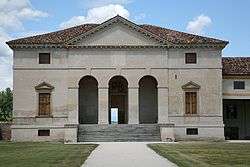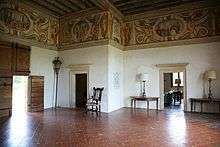Villa Saraceno
| Villa Saraceno | |
|---|---|
 | |
| General information | |
| Architectural style | Palladian |
| Town or city | Agugliaro |
| Country | Italy |
| Coordinates | 45°18′45″N 11°33′59″E / 45.31250°N 11.56639°ECoordinates: 45°18′45″N 11°33′59″E / 45.31250°N 11.56639°E |
| Construction started | 1540s |
| Completed | 1540s |
| Client | Biagio Saraceno |
| Technical details | |
| Structural system | brick and wood; limited use of stone |
| Design and construction | |
| Architect | Andrea Palladio |
Villa Saraceno is a Palladian Villa in Agugliaro, Province of Vicenza, northern Italy. It was commissioned by the patrician Saraceno family.
Architectural significance
Villa Saraceno has been dated to the 1540s, which makes it one of Andrea Palladio's earlier works. In 1570 the building was illustrated in an imagined state in its architect's influential publication "Four Books of Architecture".[1] However, the villa had been constructed in a more modest form, and existing farm buildings were retained rather than being replaced by the architect's "trade-mark" wings. The reasons for the divergence between the published plan and the actual building are not entirely clear, but it is not the only one of Palladio's villas to be different from the published plan.
The villa is one of Palladio's simpler creations. Like most of Palladio's villas it combines living space for its upper-class owners with space for uses related to agriculture. Above the "piano nobile" is a floor which was designed as a granary. As it stands today, the villa has a nineteenth-century wing which links it to a fifteenth-century building.

Restoration and current use of the villa
The villa fell into a poor state of repair in the twentieth century but retained some of its original frescoes. It was acquired in 1989 by the British charity the Landmark Trust. By 1994 the Trust had completed its restoration, converting the property, which includes adjacent farm-buildings not by Palladio, into a holiday home sleeping up to 16 people. The many people who have since stayed in the villa include Witold Rybczynski, who used it as a base when researching his book on Palladio.[2]
The restoration has been praised for its sensitivity, and since 1996 the villa has enjoyed an additional level of protection, being conserved as one of the buildings which make up the World Heritage Site "City of Vicenza and the Palladian Villas of the Veneto". The principal rooms of the villa are open to the public on a limited basis,[3] but the Trust attracted some criticism in the past for not promoting the building as part of the World Heritage Site. [4] In 2008 the Landmark Trust celebrated the 500th anniversary of Palladio's birth with a new guidebook for the Villa Saraceno in English and Italian and extended opportunities for visiting.
See also
References
- ↑ I Quattro Libri dell'Architettura, Venice 1570, libro II, p. 56. This reference is to the second book (libro) of the first edition, which was written in the author's native Italian. Since the eighteenth century the work has appeared in various English translations: the first to be published was that of Giacomo Leoni, soon followed by the (arguably superior) version of Isaac Ware. The book is still in print ISBN 0-486-21308-0 or ISBN 978-0-486-21308-8
- ↑ The Perfect House: A Journey with Renaissance Master Andrea Palladio (2002)
- ↑ The Landmark Trust | Visiting Landmark Trust properties (www.landmarktrust.org.uk), retrieved 24 April 2010 Archived December 19, 2007 at the Wayback Machine
- ↑ Joint UNESCO-ICOMOS Mission to City of Vicenza and the Palladian Villas of the Veneto, 2005 Report by UNESCO and ICOMOS, retrieved 16 February 2008
External links
| Wikimedia Commons has media related to Villa Saraceno. |
- Homes and villas abroad, Italy
- Villa Saraceno - Finale di Agugliaro - (1543) (English) (Italian)
The architecture of the Villa Saraceno is set in context by the Centro Internazionali di Studi di Architettura Andrea Palladio (www.cisapalladio.org).
